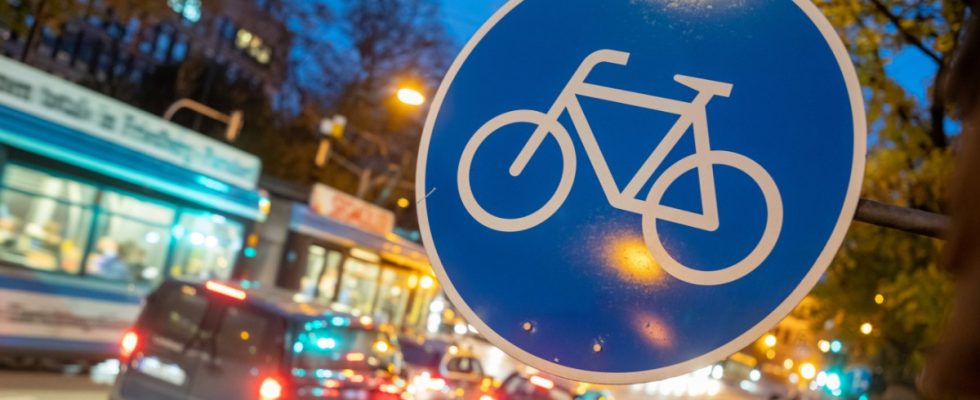Some avoid suddenly opening car doors, others chug impatiently behind cyclists: the conflict between drivers and cyclists is omnipresent on the streets of Munich, often accompanied by wild gestures, horns and yelling. Frequently, tempers get heated up because of the different interpretation of the road traffic regulations. Most things are clearly regulated. An overview of six common issues and how to resolve them.
Do cyclists have to ride on the cycle path?
The cycle path is obligatory for cyclists if it is signposted as such. This includes the round, blue and white signs for the cycle path, common footpath and cycle path and separate footpath and cycle path. The cycle path must always be driven on the right-hand side. The obligation to use does not apply only if the cycle path is objectively unusable, for example due to construction sites or weather conditions. Children under the age of ten are allowed to ride on the sidewalk. Children under the age of eight must do so and may be accompanied by people over the age of 16.
Foot and cycle path on Schwarzenbergstrasse in Obergiesing.
(Photo: Sebastian Gabriel)
The “Radverkehr Frei” sign gives cyclists the right to use paths that would otherwise be forbidden – for example in pedestrian zones. Pedestrians have priority, however, so they must not be obstructed or endangered. Illegal driving on a sidewalk is punished with at least 55 to 100 euros, disregarding a signposted cycle path costs between 20 and 35 euros.
Cyclists are allowed to drive in both directions on Brienner Straße, but cars are not.
(Photo: Tobias Hase/dpa)
Do e-bikes with a sticker have to ride on signposted cycle paths?
There are different types of electric bicycles. The most common form are the so-called pedelecs, which can reach a maximum speed of 25 km/h with pedal assistance. If the achievable maximum speed is 45 km/h, it is an S-Pedelec, which must be marked with an insurance sticker. S-pedelecs are small motorcycles and are therefore subject to the regulations for motor vehicles. Your drivers need a driver’s license that corresponds to at least the class of a scooter license (class AM). Riding on cycle paths with S-Pedelecs is prohibited and will be punished with a fine of between 15 and 30 euros.
S-pedelecs must be marked with a sticker.
(Photo: www.haibike.de | pd-f)
Which traffic lights apply to cyclists at pedestrian crossings?
In principle, the traffic lights for cyclists apply to cyclists, if available. If you are brought to an intersection that is also used by pedestrians, you must obey the traffic lights for motorists. If the traffic light is green for pedestrians but red for cars, cyclists are not allowed to turn. The only exception is if turning is permitted by an additional green arrow, pedestrians still have priority. Driving over a red traffic light is punished just as severely for cyclists as for drivers and can result in a fine of up to 180 euros and a point in Flensburg.
What rules apply to solid and dashed lines on cycle paths?
A cycle lane next to the car lane is indicated by a solid white line. Motor vehicles are not allowed to cross the solid line. An exception may only be made if it is necessary to cross the line in order to reach a parking lot or access road behind it. Motor vehicles are not permitted to stop or park on the cycle path.
On Elsenheimerstraße, an MVG bus drives right next to the protective lane for cyclists. This is marked by a dashed line.
(Photo: Matthias Ferdinand Döring)
If the line next to the car lane is not solid, but dashed, this is the separation of a so-called protective lane for cyclists. Cars are not allowed to stop or park here either, the fine starts at 55 euros. However, motorists may drive over the line if necessary, provided that this does not impede bicycle traffic.
Does the coloring of cycle paths have any meaning?
With regard to the Road Traffic Act (StVO), the coloring of cycle paths is not important. Some sections are colored red so that drivers can see them better, for example at confusing intersections or busy roads. Longer, safer stretches, on the other hand, are sometimes colored green or blue. According to surveys, cyclists feel safer on green-marked trails, while red-marked trails increase awareness. Regulations that are laid down in the StVO, for example delimiting lines, are only marked with yellow or white markings.
Red cycle path at the corner of Corneliusbrücke and Erhardtstraße.
(Photo: Robert Haas)
What rules apply in cycle streets and cycle zones?
According to information from the city, as of October 2022, there are 91 cycle streets in Munich with a total length of 43 kilometers. According to official information, Munich is still the city with the most bicycle streets in Germany. In addition, cyclists are allowed to drive in from both sides of around 400 of the approximately 700 one-way streets in Munich.
Cyclists in one of the new bicycle lanes in Veterinärstrasse at the university.
(Photo: Stephan Rumpf)
Only bicycles and e-scooters are allowed on cycle streets, unless other vehicles are additionally permitted with signs. In this case, a speed limit of 30 km/h applies. Cyclists then still have priority, are allowed to ride next to each other and cars must keep a distance of at least 1.5 meters when overtaking. However – many cyclists do not know this – right before left at intersections, unless otherwise signposted. Several cycle streets can be combined into a cycle zone. The word “Zone” instead of “Street” is then also noted on angular white signs with a blue circle and bicycle. So far, however, there are no bicycle zones in Munich.

